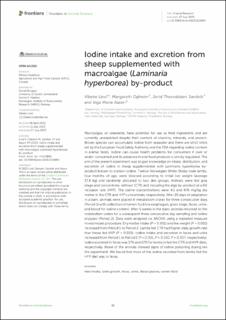Iodine intake and excretion from sheep supplemented with macroalgae (Laminaria hyperborea) by-product
Peer reviewed, Journal article
Published version

View/
Date
2023Metadata
Show full item recordCollections
Original version
Lind, V.,Opheim, M., Sandvik, J. & Aasen, I. M. (2023). Iodine intake and excretion from sheep supplemented with macroalgae (Laminaria hyperborea) by-product. Frontiers in Animal Science. 4, 9. doi: 10.3389/fanim.2023.1213890Abstract
Macroalgae, or seaweeds, have potential for use as feed ingredients and are currently unexploited despite their content of vitamins, minerals, and protein. Brown species can accumulate iodine from seawater and there are strict limits set by the European Food Safety Authority and the FDA regarding iodine content in animal feeds. Iodine can cause health problems for consumers if over or under-consumed and its presence in end food products is strictly regulated. The aim of the present experiment was to gain knowledge on intake, distribution, and excretion of iodine in sheep supplemented with Laminaria hyperborea by-product known to contain iodine. Twelve Norwegian White Sheep male lambs, four months of age, were blocked according to initial live weight (average 37.8 kg) and randomly allocated to two diet groups. Animals were fed gras silage and concentrate, without (CTR) and including the alga by-product at a 6% inclusion rate (HYP). The iodine concentrations were 4.1 and 476 mg/kg dry matter in the CTR and HYP concentrate, respectively. After 26 days of adaptation in a barn, animals were placed in metabolism crates for three consecutive days (Period 1) with collection of rumen fluid (via esophagus), grass silage, feces, urine, and blood for iodine content. After 5 weeks in the barn, animals returned to the metabolism crates for a subsequent three consecutive day sampling and iodine analyzes (Period 2). Data were analyzed via ANOVA using a repeated measure mixed model procedure. Dry matter intake (P = 0.001) and live weight (P = 0.001) increased from Period 1 to Period 2. Lambs fed CTR had higher daily growth rate than those fed HYP (P = 0.001). Iodine intake and excretion in feces and urine increased from Period 1 to Period 2 (P < 0.001, P = 0.010, P = 0.007, respectively). Iodine excreted in feces was 37% and 67% for lambs in fed the CTR and HYP diets, respectively. None of the animals showed signs of iodine poisoning during ten the experiment. We found that most of the iodine excreted from lambs fed the HYP diet was in feces.
